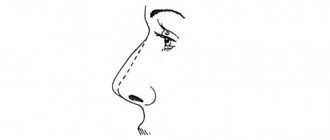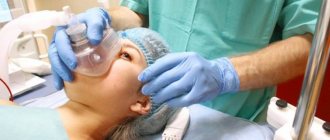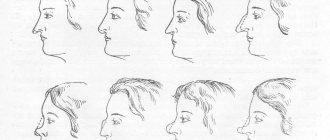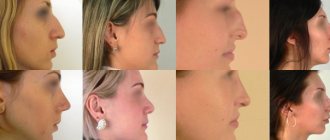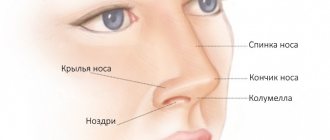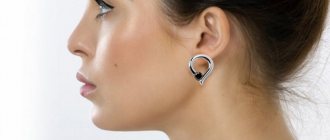Consultation with plastic surgeons with over 20 years of experience is free! Make an appointment by phone. Waiting for you! Non-surgical rhinoplasty is a minimally invasive method of nose correction using fillers and threads. The procedure is suitable for those patients who have minor nasal defects or are simply not yet ready for major surgery.
The non-surgical correction technique has both advantages and disadvantages that you should know about before deciding to undergo non-surgical rhinoplasty.
Contraindications
Like any procedure, non-surgical rhinoplasty has a number of contraindications. You must notify your doctor of any diseases, allergic reactions, or malaise. So, contraindications to non-surgical rhinoplasty:
- period of pregnancy and lactation;
- increased tissue bleeding;
- the presence of acute inflammatory processes in the body;
- elevated temperature, fever;
- infectious diseases;
- herpes (active form);
- decompensated form of diabetes mellitus;
- allergy to the drug used or its components.
Painful sensations in the post-procedural period
Immediately after the anesthetic wears off, patients may experience some pain. This is considered normal, since the tissues, although not severely, are injured. The following are formed: swelling, hematomas, asymmetry, irregularities - all this is considered within normal limits if it goes away within 2 weeks. During the first two days, to dull the pain, doctors recommend applying ice 3-4 times a day and taking painkillers and medications that help reduce swelling.
How quickly the skin heals and all unpleasant sensations go away depends on the type of skin care you take. During this period, it is recommended to use special decongestant cream-gels and antiseptics, as well as hardware and injection procedures.
Physical (fitness) and thermal (bath, sauna) loads can complicate the recovery process after a thread lift, as well as, if thread lifting was performed on the face, excessive facial expressions.
Lifting with APTOS threads. Photo from the website of D.R. Grishkyan. There are contraindications, specialist consultation is required.
Advantages and disadvantages of non-surgical rhinoplasty
The non-surgical method of nose correction cannot be considered a full-fledged alternative to correction, since despite its attractive advantages, it has a number of features or disadvantages, which we always inform our patients about.
Advantages of non-surgical rhinoplasty:
- low invasiveness of the procedure. Non-surgical rhinoplasty is performed in a medical cosmetology office. Local anesthesia may be used if necessary; general anesthesia is not used. This type of rhinoplasty is bloodless, painless, and there is virtually no recovery period (swelling, pain);
- price. The cost of installing threads or injecting fillers in the nasal area is an order of magnitude lower than traditional surgery. You have the opportunity to save on an expensive operation;
- the opportunity to see the approximate result of a surgical operation. For example, raising the tip of the nose.
Disadvantages of non-surgical rhinoplasty:
- temporary effect (in most cases, the result lasts no more than a year, and repeated correction will be necessary). With a surgical operation, the result lasts for life;
- inability to greatly change the shape of the nose. Removing the hump, changing the width and size of the nose is impossible with this technique. Only a small “disguise” of existing problems is possible.
Why can’t large volumes of fillers be injected into the nose?
Based on this procedure, patients can conclude that fillers are perfectly absorbed and removed from the body, after which the respiratory organ will take its previous shape. But not if you are constantly injecting large amounts of the drug. Since, after this, fibrosis can form in the nasal area - the growth of scar tissue that can cause deformation of the nose.
In order to prevent such an outcome, contact only trusted clinics with highly qualified specialists. After all, it is the specialists of cosmetic clinics who will conduct a full examination, calculate the dose of the drug, and also help determine which correction method will be most optimal in your case.
Operation technique
Thread correction
Non-surgical rhinoplasty with threads is effective if the patient would like to slightly shorten the length of the nose and smooth out the hump.
Threads are often used for non-surgical rhinoplasty of the tip of the nose: it can be raised with the help of such a correction. This is a fairly common request in our clinic.
The result of non-surgical rhinoplasty with threads will be visible immediately, but will last no more than 1-2 years.
If desired, the patient can repeat the procedure before the effect wears off.
The non-surgical rhinoplasty procedure is performed by a cosmetologist in a modern medical office. Local anesthesia is used. Threads (APTOS, Dermafil Happy Lift, etc.) are inserted through micropunctures into a specific area of the nose (wings or tip). Next, the doctor performs a “lift” of the required area: thus, it is possible to give the nose the desired shape. You will be able to see the effect immediately after the procedure, but it is better to evaluate the final result after 2-3 days, when the slight swelling has subsided.
Thread rhinoplasty: is it worth it?
Thread rhinoplasty is a modification of the nose using special surgical threads.
What effect should be expected from thread rhinoplasty?
Thanks to such manipulations, you can raise the tip of the nose, visually make it narrower or shorter, as well as smooth out the hump, correct asymmetry or slightly raise the back.
Often this procedure is combined with the introduction of fillers or botulinum toxins. Using an integrated approach, the muscle that lowers the tip of the nose relaxes, thereby lifting it.
It is important to understand that the result after thread rhinoplasty cannot be compared with a full-fledged surgical intervention. This procedure can only slightly harmonize the appearance and correct visual defects.
When do threads not work?
If the patient wishes to change the shape or size of the nose. If the goal is to reduce a wide and fleshy nose, you need to contact a plastic surgeon.
How long does the result last?
On average from 3 to 6 months. The effect directly depends on the individual characteristics of the patient’s body, as well as on the quality of the installed threads.
How are the threads secured?
The thread rhinoplasty procedure involves the use of special threads with notches that are secured above the bridge of the nose. The installation technique depends on the desired aesthetic result and is discussed with the patient during a face-to-face consultation.
As a rule, surgeons use 2-4 threads, which are selected based on the patient’s anatomical data, as well as skin turgor and its density.
Can the threads slip?
Specially selected threads with notches are aimed at eliminating the risk of slipping. However, in private practice there have been cases of their deformation. This is accompanied by a kind of click, after which the tissue moves and the result is lost. Therefore, it is extremely important to choose a qualified surgeon with extensive experience in this field.
Is this procedure dangerous?
Thread lifting is considered an atraumatic manipulation. The rehabilitation period is 2-3 weeks and is accompanied by slight swelling and minimal discomfort in the area where the threads are inserted. The main recommendations include the exclusion of active physical activity, as well as visiting bath complexes and solariums.
Is it possible to contour threads?
No, this is impossible. However, in the initial rehabilitation there may be some unevenness that smooths out over time.
Is it possible to perform a full-fledged rhinoplasty after installing threads?
Any foreign body in the nose (threads, filler) can complicate the work of a plastic surgeon, but this is not a contraindication to surgical rhinoplasty. When performing rhinoplasty surgery, the surgeon usually removes the remaining filler and threads.
Thread rhinoplasty is used if the patient is not ready for full rhinoplasty. If you want to harmonize your nose and correct minimal aesthetic defects, this method is just for you!
If you want to radically change the shape, back, and width of your nose, you are recommended for full-fledged rhinoplasty.
Main contraindications for thread rhinoplasty:
- Pregnancy, lactation.
- Oncological diseases.
- Diabetes.
- The presence of inflammatory processes.
- Mental illnesses.
- Intolerance to certain drugs.
Thread rhinoplasty is considered a minimally invasive procedure, due to which the list of contraindications is minimal and the risks of complications are minimized.
Advantages of thread rhinoplasty:
- Atraumatic, lack of a long rehabilitation period.
- Minimal risks of complications.
- Fast and impressive results.
- The procedure is performed under local anesthesia rather than general anesthesia.
Disadvantages of thread rhinoplasty:
- Short-term effect.
- Inability to solve breathing problems.
- Correction of only minimal aesthetic defects of the nose.
Cost of thread rhinoplasty.
The price of the procedure directly depends on the complexity of the case, the wishes of the patient, the quality of the selected threads and the qualifications of the plastic surgeon. The final cost of thread rhinoplasty is determined after an in-person examination by a doctor on an individual basis.
Carrying out the procedure
Implantation must be carried out by a qualified specialist: a dermatocosmetologist or a plastic surgeon.
All manipulations will take no more than an hour. The procedure is carried out on an outpatient basis with strict adherence to sanitary standards. For pain relief, an analgesic cream is applied to the nasal area.
Preparation
The doctor assesses the condition of the nose, collects anamnesis and gives recommendations for preparation.
He also selects the type of threads and outlines a plan for implanting ligatures. Preparatory measures:
- a week before plastic surgery, the patient undergoes blood tests to exclude infections;
- 2 weeks before, you must stop taking antibacterial and anti-inflammatory drugs, and 2 days before, medications that can thin the blood;
- 2 days in advance you should give up alcohol and smoking.
Indications
Rhinoplasty with fillers or threads is indicated only in 5-7% of cases.
Among the most common indications are:
- Drooping tip or wings of the nose;
- Wide or thin nose;
- The presence of a hump;
- Snub nose;
- The need to correct the tip of the nose;
- Asymmetry.
Cost of non-surgical rhinoplasty
| Name | Price |
| Non-surgical rhinoplasty Threaded nose correction with Happy Lift Nose threads 1 thread | 18,000 rub. |
| Rhinoplasty injection first category | 30,000 rub. |
| Rhinoplasty injection first category | 60,000 rub. |
| Primary appointment (examination, consultation) with a cosmetologist | 1,500 rub. |
In what cases is non-surgical rhinoplasty appropriate?
Non-surgical nose correction can be used both in the initial consultation of a patient who is not satisfied with the aesthetics of his nose, and for the correction of deformities after rhinoplasty has already been performed.
The most effective use of non-surgical rhinoplasty is for low nasal bridge. Excellent results are obtained when it is necessary to increase the projection of the nose, sharpen and lengthen its tip.
Non-surgical rhinoplasty photo: by resorting to non-surgical rhinoplasty, we were able to correct the obvious deformation of the patient’s nose, raise the bridge of the nose, and form a beautiful high profile of the bridge of the nose.
You can also achieve rotation (raising or lowering) of the tip of the nose, which is achieved by injecting filler into certain points. In addition, when performing non-surgical nose correction, not only fillers are used, but also botulinum toxin-containing drugs that allow you to influence the muscles of the nose and correct the direction of the trajectory of the tip of the nose. The method is also effective in correcting the nasolabial angle.
As we previously noted, a few years ago the main obstacle to the widespread development and use of contour rhinoplasty was the lack of fillers that would guarantee a stable result. Today, these fillers exist; moreover, they can be divided into temporary and permanent. At the same time, temporary fillers have a validity period from 6 months to 2 years. Permanent fillers include fat, but its use is extremely limited (there are practically no statistics on the use of fat during non-surgical rhinoplasty) and requires special knowledge, experience and indications from the surgeon.
Before and after photos: the patient came to the clinic in the hope that non-surgical rhinoplasty could solve the problems of his nose deformation. We managed to correct the consequences of an old fracture and straighten the bridge of the nose.
The most important thing that can be highlighted as a guarantee of achieving a good result is the experience of the surgeon performing non-surgical rhinoplasty, who must master traditional methods of surgical rhinoplasty, allowing him to feel and understand well both the internal structures of the nose and its external aesthetics and methods of correcting nasal deformities, as well as knowledge of the range of fillers on the market that are suitable for use in nasal contouring and the technique of their administration.
Thus, non-surgical rhinoplasty is a powerful, safe and guaranteed way to correct a number of nasal deformities, which depends on the experience and knowledge of the surgeon. This procedure is suitable for both very busy people and men who do not have time for long-term rehabilitation after traditional rhinoplasty. You see the results of nose contouring almost immediately, already the next day, when the swelling from the procedure goes away.
Anatomy of the zone: what features need to be taken into account
The outer part of the nose has a pyramidal shape. The root of the nose is located above, and its rounded tip is located below. Between the base and the tip is the bridge of the nose. The nostrils are pear-shaped openings leading into the vestibule of the nasal cavity, delimited medially by the nasal septum, and laterally by the wings of the nose.
Follow us on Instagram!
The skeleton of the external part of the nose consists of cartilaginous and bony components. The bone component is located above and is formed by the frontal, nasal and maxillary bones. The inferior cartilage consists of one septal cartilage, two lateral cartilages, two alar cartilages, and smaller alar cartilages. While the skin over the insidious part of the nose is thin, in the cartilaginous part it is thicker and contains sebaceous glands.
Rice. 1: outer part of the nose
Purpose of correction
The procedure allows you to correct the shape of the tip and wings, eliminate some aesthetic problems through tightening the soft tissues.
The specialist inserts threads through small punctures in the skin - they create a kind of collagen frame, tightening the skin and smoothing out unevenness. Externally it looks like this:
- tissues shift;
- volumes are increasing.
It is noteworthy that this technique was used by the ancient Indians. Modern techniques have been brought to perfection and allow you to achieve a natural effect quickly and painlessly.
Efficiency
The procedure is effective in solving the following problems:
- the tip of the nose is too long;
- organ prolapse;
- wide nostrils;
- small hump;
- unevenness on the bridge of the nose.
The purpose of a thread lift is to make the nose shorter and less upturned, narrow the wide base, get rid of wide wings, and beautifully shape the back. You can extend the result by applying a notch to the ligature.
Contraindications
Thread correction cannot be performed in the following cases:
- during pregnancy and breastfeeding;
- for oncology;
- for cardiac pathology;
- diseases of blood vessels and blood;
- for autoimmune disorders, tuberculosis, hepatitis;
- during a bacterial or viral infection;
- if there is damage in the area of the planned manipulations: scars, scars, etc.
Also, this technique is not suitable for patients with very fair skin.
